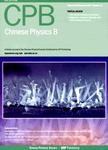Spray forming and mechanical properties of a new type powder metallurgy superalloy
Spray forming and mechanical properties of a new type powder metallurgy superalloy作者机构:School of Materials Science and Engineering University of Science and Technology Beijing Science and Technology on Advanced High Temperature Structural Materials LaboratoryBeijing Institute of Aeronautical Materials
出 版 物:《Chinese Physics B》 (中国物理B(英文版))
年 卷 期:2015年第24卷第11期
页 面:556-562页
核心收录:
学科分类:08[工学] 080502[工学-材料学] 0805[工学-材料科学与工程(可授工学、理学学位)]
基 金:supported by the National Natural Science Foundation of China(Grant Nos.50974016 and 50071014)
主 题:spray forming deposited billet mechanical property powder metallurgy (PM) superalloy
摘 要:The deposited billet of a new type powder metallurgy (PM) superalloy FGH4095M for use in turbine disk manufac- turing has been fabricated using spray forming technology. The metallurgical quality of the deposited billet was analyzed in terms of density, texture, and grain size. Comparative research was done on the microstructure and mechanical properties between the flat disk preform prepared with hot isostatic pressing (HIP) and the same alloy forgings prepared with HIP followed by isothermal forging (IF). The results show that the density of the spray-formed and nitrogen-atomized deposit billet is above 99% of the theoretical density, indicating a compact structure. The grains are uniform and fine. The billet has weak texture with a random distribution in the spray deposition direction and perpendicular to the direction of deposition. A part of atomizing nitrogen exists in the preform in the form of carbonitride. Nitrogen-induced microporosity causes the density reduction of the preform. Compared with the process of HIP+IF, the superalloy FGH4095M after HIP has better mechanical properties at both room temperature and high temperature. The sizes of the 7~ phase are finer in microstructure of the preform after HIP in comparison with the forgings after HIP+IE This work shows that SF+HIP is a viable processing route for FGH4095M as a turbine-disk material.



